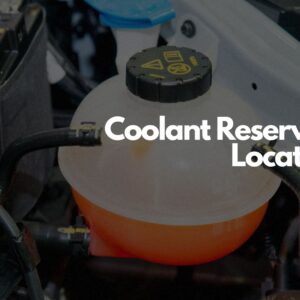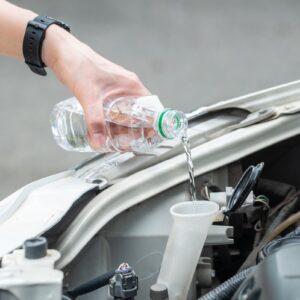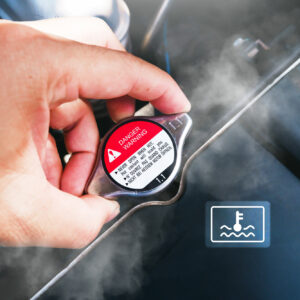What kind of antifreeze do I need for my vehicle? Many drivers have asked this question, and if you’re in the same boat, read on.
Antifreeze is one of the core components of engine coolant, which is crucial for optimal engine performance. If you live in areas with extreme temperatures, be mindful of the antifreeze replacement you buy. Certain variants are better at cooling engines, while others are better at stopping them from freezing.
How Does Antifreeze Work?
When mixed with water, antifreeze creates coolant, which circulates throughout the engine and radiator to absorb excess heat. The fluid prevents the engine from overheating while redirecting the heat outside.
Antifreeze raises the coolant’s boiling point, preventing water in the radiator from boiling and raising the temperature even further. It also lowers the freezing point of water, enabling the engine and radiator to continue functioning even at sub-zero temperatures.
What is the Difference Between Antifreeze and Coolant?
Engine coolant is a chemical compound that consists of antifreeze and water.
Antifreeze, on its own, isn’t enough to stop your vehicle’s engine from freezing or overheating. Combining it with water to create coolant helps your vehicle regulate the temperature of its engine better.
Kinds of Car Coolant
Depending on its type and the combination, antifreeze can create different kinds of coolant.
Inorganic Additive Technology (IAT)
Inorganic additive technology coolant uses inorganic additives to make the coolant less corrosive and more compatible with engines made of iron and steel. The antifreeze in IAT coolant is usually made up of inorganic salts, like silicates, phosphates, and borates.
However, the additives in the coolant’s composition can work against it. Though this coolant is highly effective, you’ll need to change the coolant more frequently because IAT deteriorates quickly.
Replacements are usually due every two years — roughly 24,000 miles. IAT coolant is usually green, and it works best with older engines made of iron and steel.
Organic Acid Technology (OAT)
Organic acid technology coolant uses ethylene glycol instead of inorganic additives.
More often than not, OAT coolants are orange, yellow, red, or purple. Their organic composition makes them more compatible with modern engines made of aluminum.

Hybrid Organic Acid Technology (HOAT)
Hybrid organic acid technology coolant combines the strengths of both IAT and OAT coolants to create a long-lasting and less corrosive fluid. Thanks to its organic composition, HOAT coolant lasts a long time and only needs changing once every five years — or 50,000 miles.
HOAT coolants usually come in orange and yellow. Like OAT coolants, They work best with modern aluminum engines.
How Do You Make Coolant with Antifreeze?
Although coolant exists to prevent your engine from overheating and freezing over, the components required to make it are both capable of freezing.
Antifreeze freezes between 0 and -5 degrees Fahrenheit, whereas water freezes at 32 degrees Fahrenheit.
However, when the two are mixed to create coolant, the freezing temperature drops exponentially. Instead, coolant freezes at a range between -35 degrees Fahrenheit and -84 degrees Fahrenheit depending on the ratio of antifreeze to water.
What Kind of Water Should You Mix With Antifreeze?
It’s best to use distilled when creating coolant with antifreeze. You want to avoid using contaminated water because unwanted chemicals can alter the chemistry needed to create coolant.
As for the ideal ratios of water and antifreeze, you’re free to use any mixture between 30% antifreeze (70/30 coolant) and 60% antifreeze (60/40 coolant). It’s important to check what’s written on the bottle to see the recommended ratios.
It’s strongly recommended to use a perfect split, with 50% water and 50% antifreeze (50/50 coolant). If you’re driving in places with colder climates, 70/30 coolant is your best bet because it has the lowest freezing point.
Frequently Asked Questions About Antifreeze and Coolant
What Kind of Antifreeze is Pink?
Coolant and antifreeze come in many colors to indicate the chemicals used. Pink antifreeze likely uses Organic Acid Technology, also known as OAT, which means there’s propylene glycol. Phosphate Hybrid Organic Acid Technology, or PHOAT, also results in pink antifreeze to indicate the use of phosphates and organic acids.
It’s also worth mentioning that many Toyota vehicles use pink coolant, but most modern vehicle manufacturers are beginning to implement pink coolant in their vehicles as well.
Does It Matter What Kind of Antifreeze You Use?
Yes, the kind of antifreeze you use matters. Every vehicle is built differently, and your vehicle owner’s manual will tell you what kind of antifreeze or coolant you should use.
Factors such as your location’s climate also determine what antifreeze you should use and how much you should mix with water. As always, consult your owner’s manual.
How Often Should Antifreeze and Coolant Be Changed?
It’s strongly recommended that you change your vehicle’s coolant once or twice a year. Coolant doesn’t last forever, and when it deteriorates, your engine will be more prone to overheating and freezing. Servicing your vehicle’s coolant is also significantly cheaper than paying for the repairs of any engine damage brought about by old or improper coolant.
If you want to prevent your vehicle’s engine from sustaining permanent damage, it’s important to keep your coolant clean and well-stocked.
Any information provided on this Website is for informational purposes only and is not intended to replace consultation with a professional mechanic. The accuracy and timeliness of the information may change from the time of publication.
































